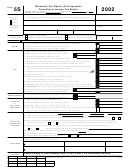Publication 102 - Wisconsin Tax Treatment Of Tax-Option (S) Corporations And Their Shareholders Page 20
ADVERTISEMENT
Publication 102
1. Basis Limit
$5,000 1996 ordinary loss passed through). For this purpose,
she computes her basis on December 31, 1997, without
reduction for the current year’s (1997) operating loss. The
The amount of loss and deductions that a shareholder
shareholder may carry over the remaining $4,000 of her
may take is limited to the shareholder’s Wisconsin basis
portion of the 1997 loss and deduct it on her returns for future
in capital stock and indebtedness of the corporation as of
tax-option (or post-termination transition period) years,
the end of the corporation’s taxable year, as described in
whenever she has basis to apply against the loss.
Part XI. If stock is disposed of during the year, figure its
basis as of the close of the day before disposition and
Example 2: A tax-option (S) corporation and its sole share-
figure the basis of indebtedness as of the close of the last
holder file returns on a calendar-year basis. The shareholder
day the person was a shareholder.
organized the corporation on January 1, 1996, with an invest-
ment of $5,000 in capital stock and a $5,000 loan to the
If a shareholder’s pro rata share of corporate losses and
corporation, represented by an interest-bearing note. The
corporation elected to be taxed under Subchapter S for federal
deductions exceeds the shareholder’s Wisconsin basis in
purposes effective for its taxable year ending December 31,
stock and indebtedness, any disallowed loss may be
1996. The corporation incurs ordinary losses for Wisconsin
carried over indefinitely. The loss may be used whenever
purposes of $6,000 and $8,000 for its taxable years ended
the shareholder has sufficient basis to apply against the
December 31, 1996, and December 31, 1997, respectively.
amount carried over in a year in which the corporation is
Interest on the note is paid when due, but no part of the loan
a tax-option corporation, or during the post-termination
principal is repaid by December 31, 1997. In addition, the
transition period, in a manner similar to the federal rules.
corporation doesn’t make any property distributions.
If in any subsequent year there is a positive basis adjust-
For Wisconsin purposes the sole shareholder deducted the
ment, this increase will be applied first to restore the
$6,000 ordinary loss for the year ended December 31, 1996,
basis in indebtedness to the extent of any prior reduction
on his 1996 calendar-year return. On the shareholder’s 1997
for any taxable year beginning after December 31, 1982,
Wisconsin return, he may deduct only $4,000 of the corpora-
tion’s $8,000 ordinary loss for its taxable year ended Decem-
before the shareholder’s stock basis can be increased.
ber 31, 1997. This amount is equal to the shareholder’s
remaining Wisconsin basis in stock and indebtedness, com-
If a shareholder’s allowable deduction for his or her pro
puted as follows: $5,000 stock investment plus $5,000 loan
rata share of the corporation’s losses results in a loss on
minus $6,000 ordinary loss for the taxable year ended Decem-
the shareholder’s Wisconsin income tax return, the loss
ber 31, 1996. The shareholder may carry over the remaining
generally is treated in the same manner as other Wiscon-
portion of the latter year’s loss ($4,000) to subsequent years
sin net operating losses. However, unlike other Wiscon-
for Wisconsin purposes.
sin net operating losses, Wisconsin tax-option (S) cor-
poration losses may be claimed even if the shareholder
Note: The losses deducted by the shareholder first reduce the
has no federal net operating loss. For losses incurred in
basis of his stock in the corporation, then the basis of the loan.
the 1980 taxable year and thereafter, a Wisconsin net
In this example, the shareholder computes the Wisconsin basis
operating loss may be carried forward against Wisconsin
of the stock and loan as follows:
taxable income for up to 15 years.
Stock
Loan
Example 1: On January 1, 1996, a shareholder invested
Original investment
$ 5,000
$ 5,000
$7,000 to acquire 50% of a tax-option (S) corporation’s capital
Dec. 31, 1996, loss deducted
(5,000 )
(1,000 )
stock. The shareholder and corporation each file returns on a
Dec. 31, 1997, loss deducted
-0-
(4,000 )
calendar-year basis and the corporation has no indebtedness
Basis on January 1, 1998
$
-0-
$
-0-
owing to the shareholder. For the 1996 calendar year, the
corporation computed a $10,000 ordinary loss on its Wiscon-
If the loan is repaid in full on January 1, 1998, and the
sin franchise or income tax return. The corporation didn’t
corporation has no taxable income for the year ended Decem-
make any distributions to the shareholder. The shareholder
ber 31, 1998, the shareholder will realize $5,000 of taxable
deducted $5,000 (50% of the $10,000 loss) on her 1996
income for Wisconsin purposes. Since the loan was evidenced
Wisconsin return.
by a note which was outstanding for more than one year, the
$5,000 is capital gain income. If, in the alternative, the loan
For the 1997 calendar year, the corporation computes a
had not been evidenced by a note, all the income upon repay-
$12,000 ordinary loss and doesn’t make any distributions. The
ment would be ordinary income.
shareholder’s share of the loss is $6,000. However, the share-
holder may deduct only $2,000 on her 1997 Wisconsin return,
Example 3: Assume the same facts as in Example 2, except
since her basis in the corporation’s capital stock on Decem-
that the corporation doesn’t repay the loan on January 1, 1998,
ber 31, 1997, is $2,000 ($7,000 original investment minus
it earns $9,000 of ordinary income for the year ended Decem-
18
ADVERTISEMENT
0 votes
Related Articles
Related forms
Related Categories
Parent category: Financial
 1
1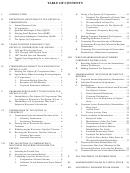 2
2 3
3 4
4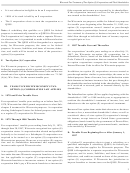 5
5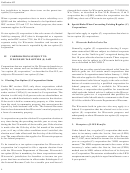 6
6 7
7 8
8 9
9 10
10 11
11 12
12 13
13 14
14 15
15 16
16 17
17 18
18 19
19 20
20 21
21 22
22 23
23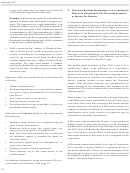 24
24 25
25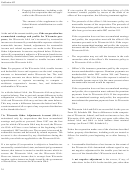 26
26 27
27 28
28 29
29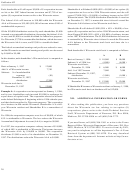 30
30




